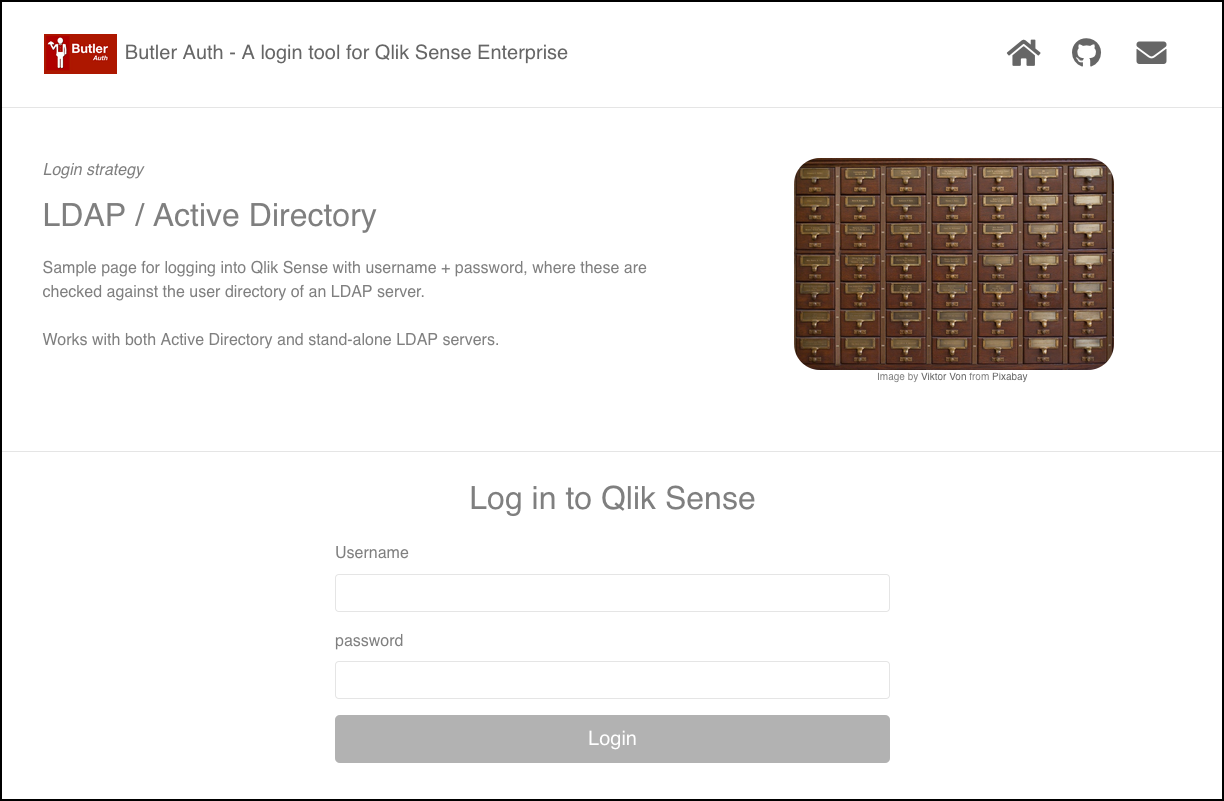Butler Auth configuration
The settings in the config file are:
ldap: # "LDAP" provider
enable: false
url: https://<FQDN>:8081 # URL where login UI for this provider is available
userDirectory: lab # Qlik Sense user directory that will be used for the authenticated user
ldapServer: # Information about the LDAP server to authenticate against
host: <ldap(s)://ldap.mydomain.com> # Both normal (ldap://) and secure (ldaps://) LDAP is supported
port: 636 # Usually 389 for LDAP and 636 for LDAPS
bindUser: '<domain\username>' # Service account used to log into the LDAP server
bindPwd: <password> # Password of service account
searchBase: '<dc=...,dc=...,dc=...>' # Base path from which authentication attempts will start
searchFilter: '(&(objectcategory=person)(objectclass=user)(|(samaccountname={{username}})(mail={{username}})))' # Filter used to get info about users in LDAP server
tls:
# Settings here will override default TLS behaviour.
# Useful for example if your cert is for another domain wrt the host name of the LDAP server.
# If a setting is empty it will simply be ignored by Butler Auth.
# Necessary if the LDAP server isusing a self-signed certificate
# Should point to a PEM coded CA certificate file.
ca:
| Field | Description |
|---|---|
| enable | Enable or disable this authentication provider. true/false. |
| url | Tells Butler Auth where it should send the user when it’s time to enter his/her username and password. A basic web page for entering LDAP credentials is included in Butler Auth, but for production scenarios you probably want to create your own login page. |
| userDirectory | The Qlik Sense Enterprise user directory that will be used once the user has been authenticated by the authentication provider. |
| host | Host where LDAP server is running. ldap://ldap.mydomain.com is insecure/not encryptet, ldaps://ldap.mydomain.com is secure. Use ldaps if possible. |
| port | Port to use on LDAP server. Usually 636 for ldaps, 389 for ldap. |
| bindUser | User to log in with on LDAP server. Usually a service account of some kind. |
| bindPwd | Password for bindUser. |
| searchBase | The base path from which authentication attempts will be done. For an Active Directory domain called sales at company mycompany.com it could be dc=sales,dc=mycompany,dc=com' |
| searchFilter | Filter used to determine if a user exists in the LDAP server. The example above should be a good starting point for standard-install Active Directory servers. |
| ca | If ldaps is used and the LDAP server is configured with proper certificates that use publicly recognizable certificate authorities, this ca section is not needed. If self-signed certificates are used you need to specify the CA certificate here for ldaps to work. |
Using Butler Auth’s built-in login page
If you want to use the built-in login page to begin with, it’s configured like this:
- Let’s assume Butler Auth is hosted at
https://butlerauth.company.com, with the http server set up to listen on port 8081.
The demo web UI showing all the authentication providers is then available athttps://butlerauth.company.com:8081/auth-providers.html. - In order to use the demo login page you should set the
ButlerAuth.authProvider.ldap.urltohttps://butlerauth.company.com:8081
Here is the built-in LDAP login page:

LDAP configuration
Configuring the directory server (which Butler Auth talks to using the LDAP protocol) is beyond the scope of this site.